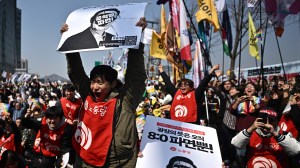It’s not your average shoplifting infraction. Retailers around the country report that they are losing tens of billions of dollars a year to organized retail crime.
“It’s like a wildfire burning out of control with no easy way to stop it,” said Burt Flickinger, managing director of Strategic Resource Group and a top consultant in retail. “The communities want the criminals to have consequences and be arrested.”
But in many cases, that’s not what’s happening.
“Either New York state or California, a person can steal up to $949 per person per store per day with no criminal consequences, no arrest, no jail time, basically a parking ticket,” Flickinger said.
People in the organized retail crime business are very aware of the threshold between petty and grand larceny. In California, petty theft is under $950 in stolen goods. In New York, it’s under $1,000.
Serial offender Michelle McKelley has been arrested more than 100 times, according to the New York Post. Often, she’s released without bail. The Post caught up with her outside of court.
“I have to go to work,” she said. “I don’t call it stealing… I’m a professional booster.”
How organized retail crime rings work
“Boosters” are the ones who steal the merchandise, sometimes hitting several stores a day. Then “fences” buy the product off boosters for a fraction of the retail price before turning around and selling to the public. Fences range in sophistication from low-level street resale at swap meets to e-fencing on Amazon and eBay.
Last year, New York’s Office of the Attorney General announced the takedown of a retail theft crime ring following a 3-year investigation. The investigation tied more than $3.8 million in stolen goods to Queens ringleader Roni Rubinov and 40 accomplices.
“Rubinov trained these employees to procure and directed the boosters to steal specific items from retailers based on sale trends from his eBay storefront,” New York Attorney General Letitia James said.
Rubinov also owned and operated pawnshops in Midtown Manhattan.
“This is just not shoplifting. This is organized crime attempting to exploit our merchants and our city,” New York City Mayor Eric Adams said.
Revolving door of crime
Despite this crackdown, Adams and the NYPD said the city’s criminal justice system is a revolving door of no consequences. In a press conference last year, they highlighted the city’s top 10 repeat offenders, including this one they called “Recidivist No. 1.”
“He’s hit one location 20 times, the same location 20 times,” NYPD Chief of Crime Control Strategies Mike Lipetri said. “And again, we’re talking about arrests here. We’ve arrested that individual 100 times. How many crimes do you think he really committed? Two hundred? Three hundred? A thousand?”
New York doesn’t even top the list. It ranks fourth among the top cities facing organized retail crime, according to the National Retail Federation.
Top cities affected by organized retail crime
| 1 | Los Angeles |
| 2 | San Francisco/Oakland |
| 3 | Houston |
| 4 | New York |
| 5 | Seattle |
| 6 | Atlanta |
| 7 (tied) | Sacramento, Chicago |
| 9 (tied) | Denver, Miami, Albuquerque |
In Seattle, a city audit said police are aware of at least four major fencing operations where they sell stolen goods online, but police staffing constraints are hurting their ability to investigate and pursue, forcing them to prioritize violent crimes over organized retail crime.
“One of the New York City retail leaders told me it’s only 900 people who are committing these crimes. It’s the same 900 people now, and it might have been 500 or 600 people before the pandemic,” Flickinger said. “But it’s not a lot of people with the right cooperation to take corrective action and identify constructive solutions.”
What do those solutions look like? Download the SAN app and enable notifications so you don’t miss part 3 of the organized retail crime series. Catch up on part 1 here.









